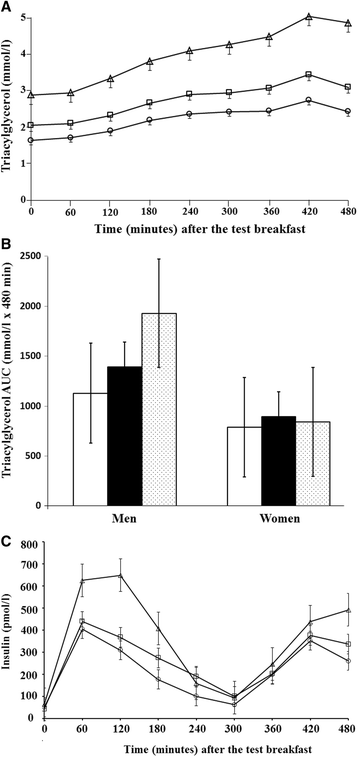The APOB insertion/deletion polymorphism (rs17240441) influences postprandial lipaemia in healthy adults
- PMID: 25793007
- PMCID: PMC4365815
- DOI: 10.1186/s12986-015-0002-9
The APOB insertion/deletion polymorphism (rs17240441) influences postprandial lipaemia in healthy adults
Abstract
Background: Apolipoprotein (apo)B is the structural apoprotein of intestinally- and liver- derived lipoproteins and plays an important role in the transport of triacylglycerol (TAG) and cholesterol. Previous studies have examined the association between the APOB insertion/deletion (ins/del) polymorphism (rs17240441) and postprandial lipaemia in response to a single meal; however the findings have been inconsistent with studies often underpowered to detect genotype-lipaemia associations, focused mainly on men, or with limited postprandial characterisation of participants. In the present study, using a novel sequential test meal protocol which more closely mimics habitual eating patterns, we investigated the impact of APOB ins/del polymorphism on postprandial TAG, non-esterified fatty acids, glucose and insulin levels in healthy adults.
Findings: Healthy participants (n = 147) consumed a standard test breakfast (0 min; 49 g fat) and lunch (330 min; 29 g fat), with blood samples collected before (fasting) and on 11 subsequent occasions until 480 min after the test breakfast. The ins/ins homozygotes had higher fasting total cholesterol, LDL-cholesterol, TAG, insulin and HOMA-IR and lower HDL-cholesterol than del/del homozygotes (P < 0.017). A higher area under the time response curve (AUC) was evident for the postprandial TAG (P < 0.001) and insulin (P = 0.032) responses in the ins/ins homozygotes relative to the del/del homozygotes, where the genotype explained 35% and 7% of the variation in the TAG and insulin AUCs, respectively.
Conclusions: In summary, our findings indicate that the APOB ins/del polymorphism is likely to be an important genetic determinant of the large inter-individual variability in the postprandial TAG and insulin responses to dietary fat intake.
Keywords: APOB gene; Insertion/deletion polymorphism; Postprandial study; Sequential test meals; Signal peptide polymorphism; Triacylglycerol.
Figures

Similar articles
-
Association of the tumor necrosis factor-alpha promoter polymorphism with change in triacylglycerol response to sequential meals.Nutr J. 2016 Jul 25;15(1):70. doi: 10.1186/s12937-016-0190-9. Nutr J. 2016. PMID: 27456841 Free PMC article.
-
Greater impairment of postprandial triacylglycerol than glucose response in metabolic syndrome subjects with fasting hyperglycaemia.Metabolism. 2013 Aug;62(8):1065-9. doi: 10.1016/j.metabol.2013.03.001. Epub 2013 Apr 15. Metabolism. 2013. PMID: 23598085
-
Impact of Lipoprotein Lipase Gene Polymorphism, S447X, on Postprandial Triacylglycerol and Glucose Response to Sequential Meal Ingestion.Int J Mol Sci. 2016 Mar 18;17(3):397. doi: 10.3390/ijms17030397. Int J Mol Sci. 2016. PMID: 26999119 Free PMC article.
-
Impact of meal fatty acid composition on postprandial lipaemia, vascular function and blood pressure in postmenopausal women.Nutr Res Rev. 2018 Dec;31(2):193-203. doi: 10.1017/S0954422418000033. Epub 2018 Mar 16. Nutr Res Rev. 2018. PMID: 29547370 Review.
-
Dietary, Physiological, and Genetic Impacts on Postprandial Lipid Metabolism.In: Montmayeur JP, le Coutre J, editors. Fat Detection: Taste, Texture, and Post Ingestive Effects. Boca Raton (FL): CRC Press/Taylor & Francis; 2010. Chapter 17. In: Montmayeur JP, le Coutre J, editors. Fat Detection: Taste, Texture, and Post Ingestive Effects. Boca Raton (FL): CRC Press/Taylor & Francis; 2010. Chapter 17. PMID: 21452474 Free Books & Documents. Review.
Cited by
-
The relationship of genetic signature for cardiometabolic risk with biomarkers of inflammatory and oxidative stress in diabetic patients.BMC Endocr Disord. 2025 Jul 1;25(1):148. doi: 10.1186/s12902-025-01973-6. BMC Endocr Disord. 2025. PMID: 40597178 Free PMC article.
-
Dietary acid load adopts the effect of ApoB ins/del genetic variant (rs11279109) on obesity trait, cardiovascular markers, lipid profile, and serum leptin level among patients with diabetes: a cross-sectional study.Sci Rep. 2024 Oct 27;14(1):25650. doi: 10.1038/s41598-024-75352-x. Sci Rep. 2024. PMID: 39465244 Free PMC article.
-
Genetics of Cholesterol-Related Genes in Metabolic Syndrome: A Review of Current Evidence.Biomedicines. 2022 Dec 13;10(12):3239. doi: 10.3390/biomedicines10123239. Biomedicines. 2022. PMID: 36551995 Free PMC article. Review.
-
Impact of Lipid Genetic Risk Score and Saturated Fatty Acid Intake on Central Obesity in an Asian Indian Population.Nutrients. 2022 Jun 29;14(13):2713. doi: 10.3390/nu14132713. Nutrients. 2022. PMID: 35807893 Free PMC article.
-
Quantile-dependent expressivity of postprandial lipemia.PLoS One. 2020 Feb 26;15(2):e0229495. doi: 10.1371/journal.pone.0229495. eCollection 2020. PLoS One. 2020. PMID: 32101585 Free PMC article.
References
-
- Kallel A, Feki M, Elasmi M, Souissi M, Sanhaji H, Omar S, et al. Apolipoprotein B signal peptide polymorphism: distribution and influence on lipid parameters in Tunisian population. Physiol Res/Academia Scientiarum Bohemoslovaca. 2007;56:411–7. - PubMed
-
- Xu CF, Tikkanen MJ, Huttunen JK, Pietinen P, Butler R, Humphries S, et al. Apolipoprotein B signal peptide insertion/deletion polymorphism is associated with Ag epitopes and involved in the determination of serum triglyceride levels. J Lipid Res. 1990;31:1255–61. - PubMed
LinkOut - more resources
Full Text Sources
Other Literature Sources
Miscellaneous

